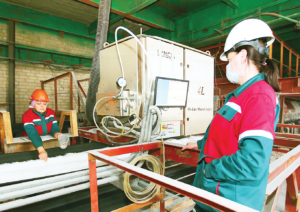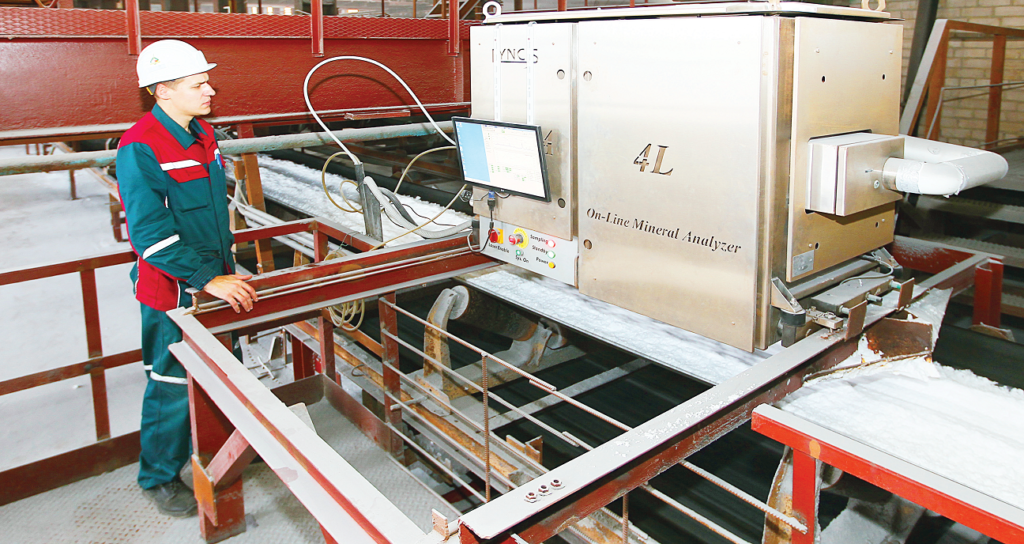In August 2020, a system for automatic quality control of potassium chloride (KCl 98%) production was put into commercial operation at global potash mining major JSC Belaruskali’s concentrating plant SOF-4 RU in Soligorsk, Belarus. The system is based on the MAYA 4L laser elemental composition analyser which is manufactured by Lithuania-based Lyncis UAB in Vilnius.
The innovative equipment uses Laser Induced Breakdown Spectroscopy (LIBS) technology and Lyncis says has been implemented in a wide variety of industries-mineral exploration and mining, ferrous and non-ferrous metallurgy, the production of phosphorus and potash fertilisers, refractories, coal and cement.
The unit is installed above the conveyor that feeds the cake of fine potassium chloride to the drying units. In real-time it measures the mass fraction of all the main elements in the manufactured product – KCl, NaCl, Ca, and Mg compounds. Constant monitoring allows prevention of overuse of the useful component (potassium) in the process, while also excluding contamination with impurities – sodium, calcium and magnesium – above the specified limits and as a result, to obtain a concentrate with a KCl content as close as possible to the specified value.
With the help of a special optical system, a laser beam with a frequency of up to five times per second is automatically focused on the concentrate cake passing along the conveyor, forming a plasma in this place. Only 1 mm³ of plasma is enough for spectrometers to carry out spectral analysis of the product through the lens system. Further, a special program processes the obtained data and determines the mass fraction of the main elements of the product. To measure the moisture content of the cake, the device analyses the hydrogen spectrum.

Vadim Naukovich, Deputy Chief Engineer of SOF-4 and responsible for technologies states: “Our task is to ‘wash off’ NaCl concentrate, Ca and Mg compounds from the cake while dissolving KCl as little as possible. The operator of the thickening and centrifugation department can control the chemical composition of the concentrate cake according to the readings of the laser analyser and manually control the process to maintain its quality by washing off using water in centrifuges. However, the difficulty is that the technological process is characterised by certain fluctuations and to maintain an economical mode of washing-off the concentrate cake, the operator must frequently change the water flow rate. The automatic process control system has become an ideal solution for us. Today, the operator sets the key parameters for this system – the required NaCl content and compares this with the NaCl value measured by the MAYA analyser and controls the water supply for washing-off the concentrate cake. To make the device work with maximum efficiency, the entire adjustment of the laser analyser was carried out by taking product samples on the conveyor and measuring the mass fractions of KCl, NaCl, H2O, Ca, Mg compounds. And this is the merit of the staff of the central laboratory of the 4th RU. It was their high qualifications, coupled with the most modern technical level of the lab equipment, that made it possible to configure the device for such a complex product as concentrate cake. During the tuning process, more than a hundred samples were taken, and a chemical analysis of each was performed according to five parameters.”
Irina Selezneva, Head of the Halurgical Department’s Central Laboratory: “The implementation of the conveyor laser analyser MAYA 4L required a fundamentally new approach to the work performed by the specialists of the central laboratory. The key to obtaining the required accuracy of the results is, first of all, a very scrupulous sampling of the product transported on a high-speed conveyor. So, the resulting averaged sample should consist of repeatedly sampled portions of the material in a defined time interval. This requires additional recording of the start and end times of sampling, storage of spectral data, with the help of which, if necessary, changes are made to the calibration of the instrument and other settings that can affect the accuracy characteristics. It should be noted that the duties of the central laboratory specialists include monitoring of the operation of the laser analyser MAYA 4L during the production of technical types of products.”

Anastasia Stanevich, Head of the Quality Control Department of the main production plant of JSC Belaruskali: “Currently the control of technical potassium chloride for the content of sodium, calcium and magnesium ions is carried out by chemical analysis laboratory assistants at a certain frequency. For example, the mass fraction of NaCl is determined by the flame photometric method every two hours. The mass fraction of NaCl is determined by the flame photometric method every two hours. We expect that the introduction of a laser analyser at the plant will allow obtaining the necessary data on the chemical composition of the product in real-time, improving the controllability of the technological process parameters and, as a result, reducing the number of products that do not meet the technical requirements. It is worth saying that Belaruskali is not a pioneer in this area. According to the manufacturer of conveyor laser analysers MAYA 4L (Lyncis company), our analyser is the fourth instrument used in the potash industry. Before us, the Russian Uralkali and the Mosaic enterprise (Canada) bought it for dry product analysis. But the application on a wet product, in the so-called concentrate cake after the centrifugation step, is a more difficult task. However, this is what makes it possible to monitor and control the technological process at the early stages.”
Future opportunities for quality control in Belaruskali include application of analyser data to control quality indicators at the stage of vacuum crystallisation; measuring the qualitative composition of the ore to calculate the mass fraction of the insoluble residue; and use of data on the content of Ca and Mg compounds in the product for calculating (predicting) the caking and fluidity of the product.











